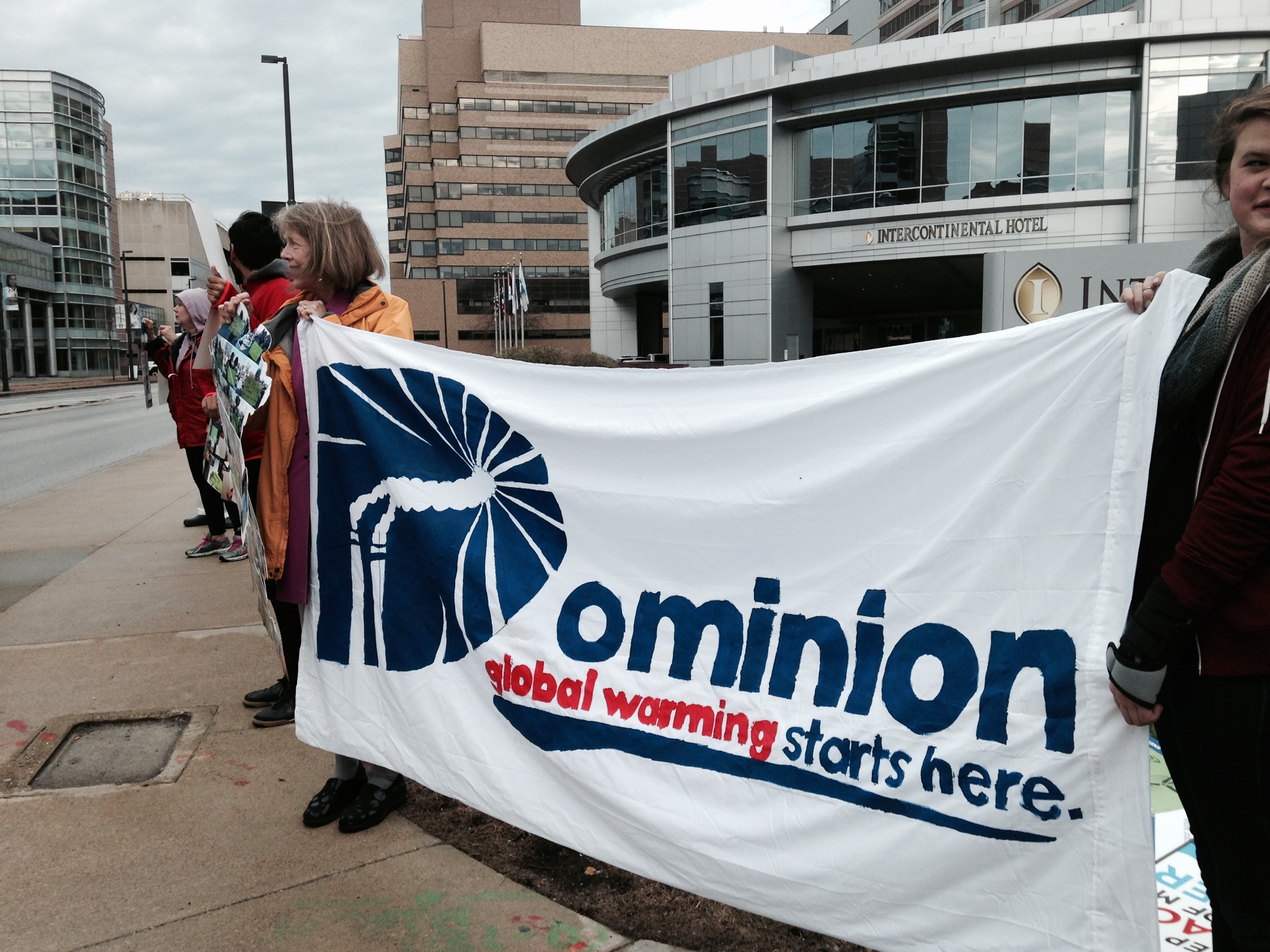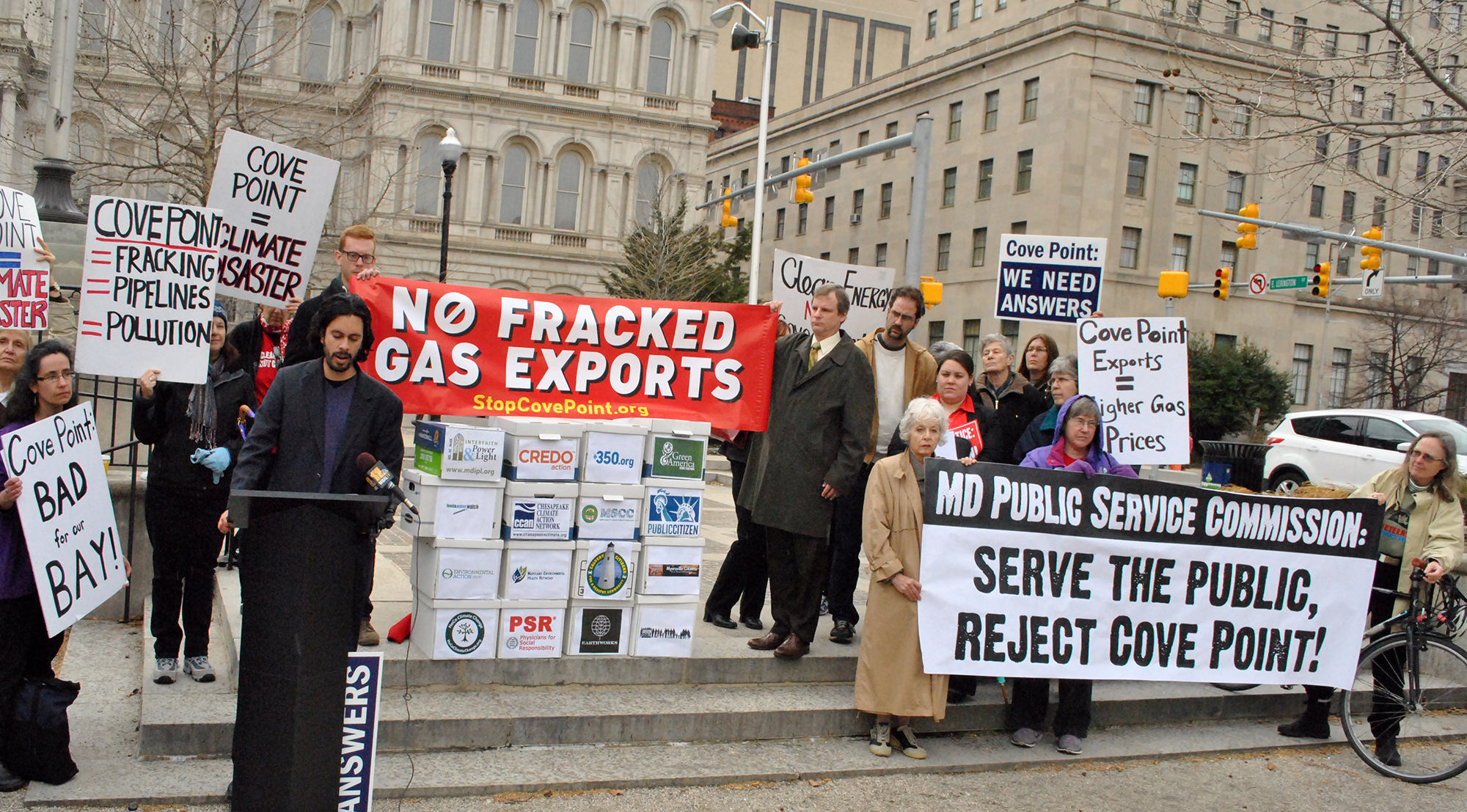Calvert Citizens for a Healthy Community
Contact:
Sue Allison: 410-474-0262, sueallison@comcast.net
Tracey Eno: 410-326-4222, traceyeno@comcast.net
Calvert County Community Group Demands Cove Point Answers and Safety Risk Assessment in the Wake of Plymouth, Washington LNG Facility Explosion
Citizens demand a full and transparent quantitative risk assessment of Cove Point hazards—including explosion risks—especially given the LNG export facility would be the first ever located so close to so many people
Seeing ‘our lives are literally on the line,’ citizens say they will no longer accept ‘business as usual’ at FERC and ‘vague assurances’ from Dominion
The liquefied natural gas facility explosion that rocked a Plymouth, Washington community on Monday, March 31, 2014, has Lusby residents demanding answers about a proposed expansion that would enable the Dominion Cove Point liquefied natural gas (LNG) terminal to become an LNG export facility. The incident should also reignite debate on the Federal Energy Regulatory Commission’s role as a sole siting authority and safety regulator, given the agency’s apparent ongoing failure to fully consider the worst-case, compound safety risks of locating LNG facilities within close proximity to people’s homes. [1]
In light of the concerns and questions outlined below, Calvert Citizens for a Healthy Community is demanding that the Federal Energy Regulatory Commission complete an objective and transparent quantitative risk assessment for Dominion’s proposed LNG export facility—an assessment open to public scrutiny and including all potential mishaps, including the worst-case domino effect of explosions like the one that occurred last week in Plymouth.
If FERC refuses to do such an analysis, we call on Governor O’Malley to order the Maryland Department of Natural Resources to conduct a similarly thorough updated risk analysis. With our and our neighbors’ lives literally on the line, we deserve no less.
WHAT WE KNOW: Dominion’s plan for Cove Point poses unique safety risks and vulnerabilities that could make the consequences of a similar explosion far more severe.
The still unexplained explosion and subsequent fire at the Williams Northwest Pipeline Facility in Washington State shook homes more than a mile away, injuring five workers and sending a “mushroom cloud” of black smoke into the air, according to the Associated Press.[2] Of special concern to Lusby residents, shrapnel from the explosion caused the failure of a single containment LNG storage tank, which led to the formation of a flammable vapor cloud and the evacuation of residents within a two-mile radius. As reported by Reuters, local authorities feared that a second blast could level a 0.75 mile “lethal zone” around the plant.[3]
The day after the horrific incident, LNG expert Jerry Havens, who helped develop the vapor dispersion models that federal regulators used until recently to evaluate hazards from similar facilities, went on record with The Oregonian [4]:
“We’re still learning about the safety of all these ventures because we’re moving into a whole new area where we’re handling such large amounts of LNG. … We’re talking about so much energy and so much potential for a catastrophic event to occur. We should really think about whether we should allow these things to be built close to any population center.”
The events in Plymouth, Washington were a chilling warning for Lusby residents, especially given the following factors:
- The tanks in Plymouth were single containment tanks, considered the lowest integrity tanks with respect to protecting nearby residents from LNG spills and the resulting flammable vapor clouds.
- The tanks at Cove Point are also single containment tanks. Yet, it should be noted that the largest tanks at the Cove Point terminal are designed to hold more than twice as much LNG volume as the tanks in Plymouth, WA.
- Unlike the Plymouth site, which is in a relatively remote area, the Cove Point site is located within 4,500 feet of approximately 360 homes and is adjacent to a public park.
- The proposed Cove Point export terminal footprint would crowd together additional hazardous processes that the Plymouth site doesn’t have, including a large scale liquefaction train utilizing high pressure, highly explosive liquefied propane gas.
WHY WE’RE CONCERNED: Dominion’s export plan is inherently more dangerous. Meanwhile, a state risk analysis from 2006 indicates that flash fire hazards ALREADY extend offsite at Cove Point, contradicting Dominion and FERC assurances.
If approved, the Dominion facility will be only the second LNG export facility ever built in the lower 48 states and will be the only LNG export facility to ever be built in such a densely populated area. LNG export terminals are believed to be inherently more hazardous than LNG import terminals. The explosion of a liquefaction train at an LNG export terminal in Algeria in 2004 caused massive devastation, killing 27 people and injuring more than 70 people.
FERC is well aware of the Algeria incident—they sent representatives to study it. Bill Powers, an engineer based in California who has studied LNG terminals, along with siting issues for both onshore and offshore proposals, also studied the Skikda, Algeria plant disaster. Noting that Halliburton engineers had missed a weak link in their safety planning for the facility, Powers delivered this stern warning [5]:
“That highlights the importance of putting these facilities in places where, no matter what, people will not be at risk. If a company like Halliburton missed a scenario that could cause this, that tells us that we cannot account for all possible accident scenarios at LNG facilities.”
The members of Calvert Citizens for a Healthy Community are demanding answers that go beyond the mere assurances Dominion executives have given citizens and local leaders that no risks from the new expansion will go offsite. In fact, Lusby citizens have recently become aware of a report commissioned by the Maryland Department of Natural Resources (DNR) that appears to directly contradict Dominion’s assurances [6]:
- Apparently, Maryland DNR officials were tasked with producing an independent risk analysis of the 2006 Cove Point expansion, which included the two largest LNG single containment tanks on the site today.
- The DNR report was a quantitative risk assessment that looked at every possible mishap scenario, including terrorism. The DNR report clearly shows that risks DO extend offsite as the plant exists today.
- Indeed, if one of the new Cove Point tanks were to rupture and spill all of its contents, according to a chart on page 23 of that report, citizens within 1,300 meters (4,265 ft.) of that failed storage tank could be exposed to a fatal flash fire risk.
The DNR study of the last expansion appears to be much more extensive from a safety perspective than the limited prescriptive hazard assessment utilized by FERC. The worst mishap scenario referenced in the FERC Environmental Impact Statement for the 2006 Dominion Cove Point expansion was a one hour LNG storage tank leak from a 24 inch sump line into a sub-impound area. [7] The Plymouth, WA incident proves that a one hour LNG leak from an LNG tank is not the worst-case scenario at an LNG facility in the United States.
Lusby residents are demanding answers of our local, state and federal regulatory agencies. Specifically, we demand to know:
- Why were Lusby residents never informed about the involuntary fatal risk hazards we were exposed to with the last expansion at Cove Point?
- Would full containment tanks (in lieu of single containment tanks) have mitigated those risks? [8]
- If FERC safety criteria stipulate that no fatal hazards from LNG terminals may extend offsite, why was the last expansion approved by FERC?
WHAT WE DEMAND: FERC must complete a comprehensive quantitative risk assessment of the worst-case, compound explosion hazards of Dominion’s LNG export facility—involving the full and open participation of residents living in its shadow.
Dale Allison, a father from Lusby, Maryland who is a retired U.S. Navy civilian aerospace engineer, responded to the news of the Plymouth LNG facility explosion with a fourth submittal to FERC’s docket on the Dominion Cove Point LNG export expansion, reiterating his concerns regarding the explosive hazards which residents will face with the addition of a utility-scale power plant and a large-scale, extremely hazardous liquefaction train at the already crowded footprint of the Dominion property, which is less than a half mile from his home. [9] Allison reacted to the events in Plymouth:
“The unfortunate mishap which just occurred at the Plymouth LNG facility once again highlights the absolute requirement that LNG terminals only be sited in remote locations. Cove Point is not that site.
“But, if you insist on proceeding, here is what we require. Because the proposed Cove Point liquefaction site is so tightly packed with hazardous process equipment and materials, and because there are so many homes in close proximity, we demand that a full quantitative risk assessment be performed that not only looks at ALL individual mishaps, but also addresses ALL POSSIBLE MISHAP ESCALATIONS. Unfortunately, the Plymouth, WA mishap also shows us that escalations are REAL. A full QRA is the only way that all residents living close to the Cove Point plant can possibly know the full cumulative risk they face—their probability of loss of life—based on their separation distance from the plant.”
Dale’s wife Sue Allison, who has become quite adept at translating her husband’s engineering jargon for neighbors, explained it this way:
“I think the Plymouth incident highlights the fact that even when safety precautions are taken, accidents can happen and one mishap can lead to another, and another. In Plymouth there was an explosion, which led to shrapnel flying through air, which led to a ruptured LNG storage tank, which led to an LNG leak, which led to a flammable vapor cloud, which led to a two-mile evacuation. In a word, there was a serious ‘escalation’ event in Plymouth.
“We continue to hope that FERC will require an Environmental Impact Statement (EIS) for Cove Point, but whether the safety analysis for the Dominion expansion is done as part of an Environmental Assessment or an EIS, it must be done right and it must consider worst-case scenarios for residents, which would include escalation events. Residents are often told by our elected officials that we really don’t have a right to complain about the expansion because we bought our homes knowing the plant was there and the expansion will be built inside of the existing Dominion footprint. But the fact that Dominion’s Cove Point facility is constrained by that footprint is exactly why we should be concerned—the closer the hazardous equipment and materials are on site, the greater the chances are that a mishap can escalate.
“I recently spoke to a mother of young children whose house faces the plant on Cove Point Road. She explained that she is very anxious about the expansion. FERC’s safety analysis must be able to show that mother, based on how close her house is to the proposed expansion, exactly what her family’s safety risk would be should any foreseeable accident happen on site, which could include an explosion, a full tank leak, or both. If an objective QRA, done right, shows that the expansion will subject residents to an unacceptable level of safety risk, Dominion and our Calvert County government should start planning on buying some houses.”
The lesson from Plymouth is clear: It can no longer be “business as usual” at FERC where the safety of residents is concerned. The stakes are way too high at Cove Point. The members of Calvert Citizens for a Healthy Community continue to believe that Cove Point is not an appropriate site for such a hazardous endeavor. We stand behind our neighbor, Dale Allison, who has spent countless hours researching these safety issues to protect his family and his neighbors. We join him in his call to FERC for an objective, transparent QRA that is open to public scrutiny and that includes all credible mishaps, including explosion mishaps and escalation events.
If FERC refuses to do such an analysis, we call on Governor O’Malley to instruct the Maryland Department of Natural Resources to do another independent risk analysis for the current expansion—one that will become a public document.
Our lives are literally on the line. We deserve nothing less. We will no longer accept vague assurances about Dominion being a “good neighbor.” We are all good neighbors. It is time to get all the safety facts out on the table.
###

CONSIDER THIS: An 850 foot radius from the LNG storage tank that was ruptured at the Plymouth, WA facility reaches the boundry of that site (see graphic above). An 850 radius from the proposed location of the gas turbine compressors at the Cove Point terminal puts you at the front doors of homes on Cove Point Road!

[1] “Some community groups and government officials fear that LNG terminals may expose nearby residents to unacceptable hazards. Ongoing public concern about LNG safety has focused congressional attention on the exclusivity of FERC’s LNG siting authority, proposals for a regional siting process, the lack of ‘remote’ siting requirements in FERC regulations, state permitting requirements under the Clean Water Act and the Coastal Zone Management Act, terrorism attractiveness of LNG, the adequacy of Coast Guard security resources, and other issues.” [Liquefied Natural Gas (LNG) Import Terminal: Siting, Safety, and Regulation, Paul W. Parfomak, December 14, 2009, RL32205]
[2] “Blast Rocks Washington Gas Plant; 5 Workers Hurt.” Associated Press, March 31, 2014, http://abcnews.go.com/US/wireStory/hurt-natural-gas-blast-washington-plant-23129473
[3] “Blast at U.S. LNG site casts spotlight on natural gas safety.” Reuters, April 6, 2014, http://news.yahoo.com/blast-u-lng-casts-spotlight-natural-gas-safety-111335070–sector.html?soc_src=copy
[4] “Gas explosion at LNG facility in Washington prompts concerns about proposed export terminals in Oregon.” The Oregonian, April 1, 2014, http://www.oregonlive.com/business/index.ssf/2014/04/gas_explosion_at_lng_facility.html
[5] “Report sheds new light on LNG blast in Algeria,” Source: Washington Times, April 14, 2004, http://www.gasandoil.com/news/2004/05/nta41868
[6] “Cove Point LNG Terminal Expansion Project Risk Study.” Maryland Department of Natural Resources, June 28, 2006 (Revised January 14, 2010), http://org.salsalabs.com/o/423/images/CovePoint_Expansion_Risk_Study_MDDNR_UpdateJan2010.pdf
[7] Draft Environmental Impact Statement for Dominion Cove Point LNG, LP & Dominion Transmission, Inc. ‘s Expansion Project under CP05-130 et al., 10/28/2005, Accession #20051028-4000, Environmental Analysis Section page 4-158.
[8] A description of full containment LNG tanks available at this link: http://www.canaportlng.com/storing_lng.php.
[9] Mr. Allison’s letter to FERC regarding the Plymouth, WA incident is submittal # 20140402-5033, Case #CP 13-113; his previous FERC submittals are # 20140331-5110 March 31, 2014, Submittal # 20140307-5131 March 7, 2014, and submittal # 20140205-5035 February 5, 2014.






